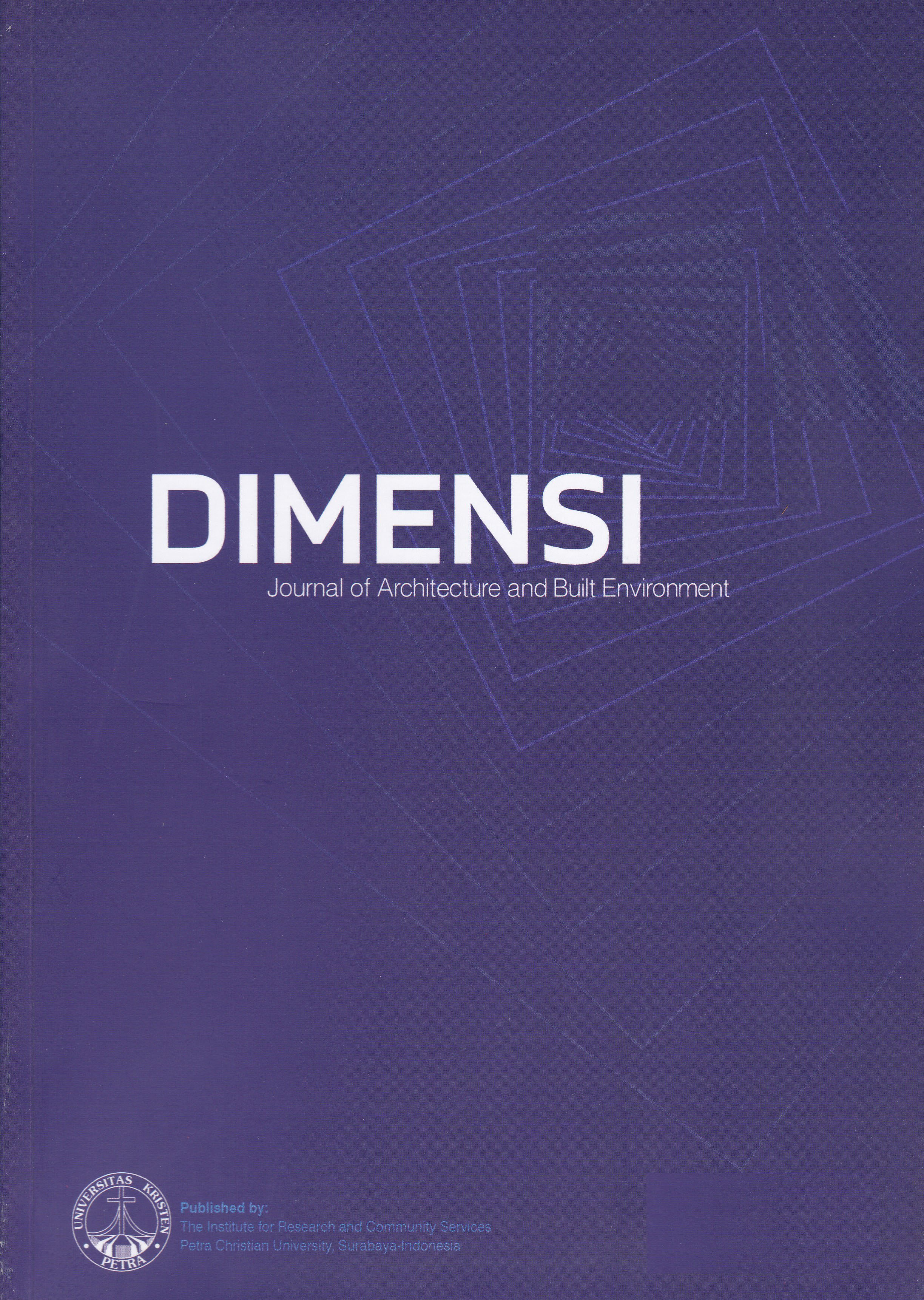A COMPARISON OF HEAT PERFORMANCE BETWEEN GREEN ROOFS ON CONCRETE AND GREEN ROOFS ON CORRUGATED ZINC
DOI:
https://doi.org/10.9744/dimensi.47.2.55-64Keywords:
greenroof, thermal performance, concrete, corrugated zincAbstract
Green roofs are generally applied to concrete roofed buildings. This study compares the thermal performance of green roofs that occur in corrugated concrete and zinc to expand green roof innovation. The study experimented on a method using the 2011 Ecotect computer simulation. The results showed that the difference in temperature reduction in corrugated zinc was higher than in concrete. Changes in heat outside the roof space on both have a number that has a relatively small difference, but the difference in heat is visible in the inner space. Based on the thermal performance of the roof, the use of corrugated zinc roofs as the base of the green roof in the building could be an alternative green roof material besides concrete.Downloads
References
Altomonte, S., Schiavon, S., Kent, M. G., & Brager, G. (2017). Indoor environmental quality and occupant satisfaction in green-certified buildings. Building Research and Information, 1–20. https://doi.org/10.1080/09613218.2018.1383715
Aly, A. M., Chokwitthaya, C., & Poche, R. (2017). Retro fi tting building roofs with aerodynamic features and solar panels to reduce hurricane damage and enhance eco-friendly energy production. Sustainable Cities and Society, 35(October 2016), 581–593. https://doi.org/10.1016/j.scs.2017.09.002
Ambrosini, D., Galli, G., Mancini, B., Nardi, I., & Sfarra, S. (2014). Evaluating Mitigation Effects of Urban Heat Islands in a Historical Small Center with the ENVI-Met® Climate Model. 7013–7029. https://doi.org/10.3390/su6107013
Baraldi, R., Neri, L., Costa, F., Facini, O., Rapparini, F., & Carriero, G. (2019). Ecophysiological and micromorphological characterization of green roof vegetation for urban mitigation. Urban Forestry and Urban Greening. https://doi.org/10.1016/j.ufug.2018.03.002
Carbone, M., Garofalo, G., Nigro, G., & Piro, P. (2014). A conceptual model for predicting hydraulic behaviour of a green roof. Procedia Engineering, 70, 266–274. https://doi.org/10.1016/j.proeng.2014.02.030
Carvalho, D., Martins, H., Marta-almeida, M., Rocha, A., & Borrego, C. (2017). Urban Climate Urban resilience to future urban heat waves under a climate change scenario : A case study for Porto urban area ( Portugal ). Urban Climate, 19, 1–27. https://doi.org/10.1016/j.uclim.2016.11.005
Costanzo, V., Evola, G., & Marletta, L. (2016). Energy savings in buildings or UHI mitigation? Comparison between green roofs and cool roofs. Energy and Buildings, 114, 247–255. https://doi.org/10.1016/j.enbuild.2015.04.053
Creswell, J. W. (2014). Research Design: Qualitative, Quantitative, and Mixed Method. In Research design Qualitative quantitative and mixed methods approaches. https://doi.org/10.1007/s13398-014-0173-7.2
Gaspari, J., & Fabbri, K. (2019). Greening Actions and the Related Potential Impacts on Outdoor Comfort in a Dense Built Environment. IOP Conference Series: Earth and Environmental Science, 290(1). https://doi.org/10.1088/1755-1315/290/1/012163
Ge, Z., Xu, G., Poh, H. J., Ooi, C. C., & Xing, X. (2019). CFD simulations of thermal comfort for naturally ventilated school buildings. IOP Conference Series: Earth and Environmental Science, 238(1). https://doi.org/10.1088/1755-1315/238/1/012073
Gromke, C., Blocken, B., Janssen, W., Merema, B., van Hooff, T., & Timmermans, H. (2015). CFD analysis of transpirational cooling by vegetation: Case study for specific meteorological conditions during a heat wave in Arnhem, Netherlands. Building and Environment, 83, 11–26. https://doi.org/10.1016/j.buildenv.2014.04.022
Herrera, J., Flamant, G., Gironás, J., Vera, S., Bonilla, C. A., Bustamante, W., & Suárez, F. (2018). Using a hydrological model to simulate the performance and estimate the runoffcoefficient of green roofs in semiarid climates. Water (Switzerland), 10(2). https://doi.org/10.3390/w10020198
MacIvor, J. S., Cadotte, M. W., Livingstone, S. W., Lundholm, J. T., & Yasui,
S. L. E. (2016). Phylogenetic ecology and the greening of cities. Journal of Applied Ecology, 53(5). https://doi.org/10.1111/1365-2664.12667
Park, S. J., Choi, W., Kim, J. J., Kim, M. J., Park, R. J., Han, K. S., & Kang, G. (2016). Effects of building–roof cooling on the flow and dispersion of reactive pollutants in an idealized urban street canyon. Building and Environment, 109(2), 175–189. https://doi.org/10.1016/j.buildenv.2016.09.011
Qin, H., Hong, B., & Jiang, R. (2018). Are green walls better options than green roofs for mitigating PM10 pollution? CFD simulations in urban street canyons. Sustainability (Switzerland), 10(8). https://doi.org/10.3390/su10082833
Rafael, S., Vicente, B., Rodrigues, V., Miranda, A. I., Borrego, C., & Lopes, M. (2018). Impacts of green infrastructures on aerodynamic fl ow and air quality in Porto ’ s urban area. Atmospheric Environment, 190(July), 317–330. https://doi.org/10.1016/j.atmosenv.2018.07.044
Rakotondramiarana, H., Ranaivoarisoa, T., & Morau, D. (2015). Dynamic Simulation of the Green Roofs Impact on Building Energy Performance, Case Study of Antananarivo, Madagascar. Buildings, 5(2). https://doi.org/10.3390/buildings5020497
Shafique, M., Kim, R., & Rafiq, M. (2018). Green roof benefits, opportunities and challenges – A review. Renewable and Sustainable Energy Reviews, 90(March), 757–773. https://doi.org/10.1016/j.rser.2018.04.006
Silva, C. M., Gomes, M. G., & Silva, M. (2016). Green roofs energy performance in Mediterranean climate. Energy and Buildings, 116, 318–325. https://doi.org/10.1007/s12197-016-9374-6
Stovin, V., Vesuviano, G., & De-Ville, S. (2017). Defining green roof detention performance. Urban Water Journal, 14(6), 574–588. https://doi.org/10.1080/1573062X.2015.1049279
Van Renterghem, T., Hornikx, M., Forssen, J., & Botteldooren, D. (2013). The potential of building envelope greening to achieve quietness. Building and Environment, 61, 34–44. https://doi.org/10.1016/j.buildenv.2012.12.001
Vera, S., Pinto, C., Tabares-Velasco, P. C., & Bustamante, W. (2018). A critical review of heat and mass transfer in vegetative roof models used in building energy and urban enviroment simulation tools. In Applied Energy (Vol. 232).
Downloads
Published
How to Cite
Issue
Section
License
Authors who publish with this journal agree to the following terms:
- Authors retain copyright and grant the journal right of first publication with the work simultaneously licensed under a Creative Commons Attribution License that allows others to share the work with an acknowledgement of the work's authorship and initial publication in this journal.
- Authors are able to enter into separate, additional contractual arrangements for the non-exclusive distribution of the journal's published version of the work (e.g., post it to an institutional repository or publish it in a book), with an acknowledgement of its initial publication in this journal.
- Authors are permitted and encouraged to post their work online (e.g., in institutional repositories or on their website) prior to and during the submission process, as it can lead to productive exchanges, as well as earlier and greater citation of published work (See The Effect of Open Access).



















